Introduction
Historically, the recommended management for biochemically recurrent prostate cancer patients following maximal pelvic therapy with no metastasis on conventional imaging has been disease monitoring, with androgen deprivation therapy (ADT) reserved for metastatic disease development. Studies of the natural history of such patients have demonstrated that the median time to development of metastases is approximately eight years, with 82% of patients remaining free of conventional imaging-defined metastasis 15 years following surgery.1It has become clear, however, that this is a heterogeneous population of patients with variable prognoses. In addition to Gleason Score and time from treatment to biochemical recurrence, PSA doubling time (PSADT) has emerged as a significant predictor of adverse outcomes in this patient population. In a cohort of 379 patients with biochemical recurrence following radical prostatectomy, those with a PSADT <15 months accounted for 90% of all deaths.2 Significantly, shorter PSADTs were associated with progressively worse overall survival outcomes, with those having a PSADT < 9 months having an almost 9-fold increase rate of mortality, compared to those with a PSADT ≥15 months.3 As such, it has become clear that there is a mortality risk associated with high-risk biochemical recurrence, and a risk-stratified approach to the management of such patients is warranted.
Systemic hormonal therapy has emerged as a guideline-recommended management option for higher-risk biochemically recurrent, non-metastatic hormone-sensitive prostate cancer (M0 HSPC) patients.4 While ADT monotherapy has demonstrated overall survival benefits in this population,5 there is a rationale for further intensification with androgen receptor pathway inhibitors (ARPIs) in biochemically recurrent patients with short PSADTs, given their survival benefits in the metastatic hormone-sensitive setting.
Recently, the results of two randomized phase III trials of systemic therapy intensification with ARPIs in biochemically recurrent M0 HSPC patients with short PSADTs ≤9 months have been published: EMBARK6 and PRESTO.7 In this Center of Excellence article, we will discuss the results of these two trials, with a specific focus on the data from EMBARK.
PRESTO
PRESTO (AFT-19) is an open-label, randomized phase III trial of post-radical prostatectomy biochemically recurrent patients with a PSADT ≤9 months, a serum PSA level ≥0.5 ng/ml, and no evidence of metastases on conventional imaging. Metastases on prostate-specific membrane antigen (PSMA) positron emission tomography (PET)/computed tomography (CT) or Fluciclovine F18 (Axumin®) PET were permitted. Overall, 533 patients underwent 1:1:1 randomization to a 52-week finite treatment course of:- ADT monotherapy
- ADT + apalutamide
- ADT + apalutamide + abiraterone acetate/prednisone
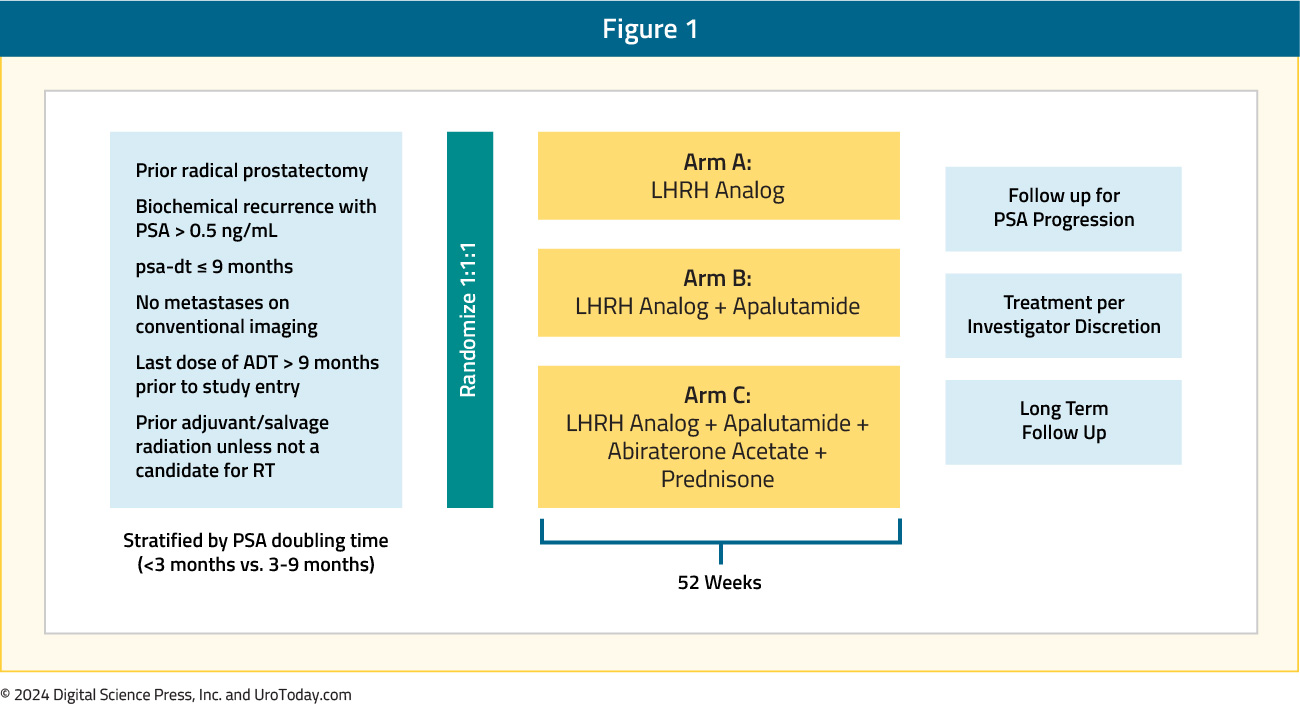
The median serum PSA level at study entry was 1.8 ng/ml, and the median interval from radical prostatectomy to study entry was 4.4 years. Nearly 75% of patients had a PSADT of 3 to 9 months, and 25% had a PSADT <3 months. 85% of patients had received prior adjuvant/salvage pelvic radiotherapy, with 42% having received prior ADT (>9 months since study entry). The median follow-up at the first interim analysis was 21.5 months.
With regards to the primary study endpoint of PSA progression-free survival (PSA-PFS), defined as serum PSA >0.2 ng/mL after treatment completion, both experimental arms significantly prolonged PSA-PFS, compared with the control arm:
- ADT + apalutamide: median, 24.9 months versus 20.3 months for ADT (HR 0.52, 95% CI 0.35–0.77, p = 0.00047)
- ADT + apalutamide + abiraterone acetate/prednisone: median, 26 months versus 20 months (HR 0.48, 95% CI 0.32–0.71, p = 0.00008)
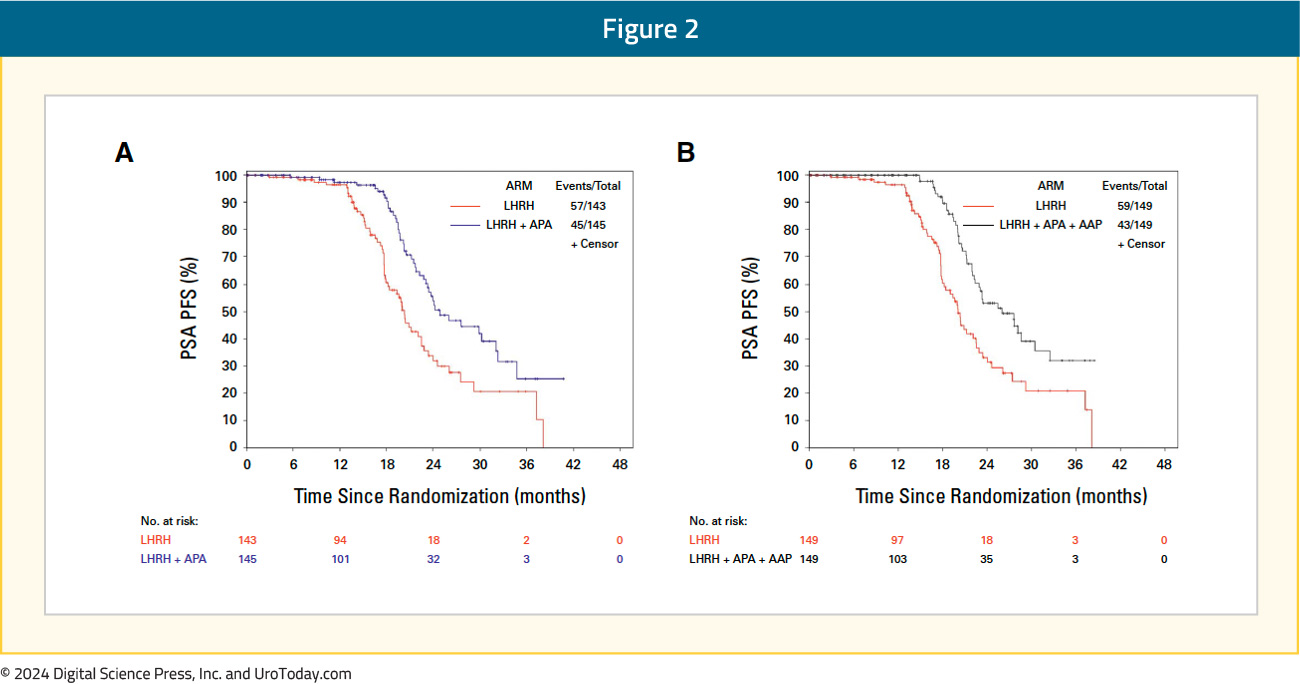
There were no significant differences in the median time to testosterone recovery across the three arms, ranging between 3.8 and 4.7 months. Serious adverse events were experienced in 8%, 9%, and 17% of patients in the ADT alone, ADT + apalutamide, and ADT + apalutamide + abiraterone acetate/prednisone arms, respectively. Hypertension was the most common grade ≥3 adverse event, observed most frequently in the ADT + apalutamide + abiraterone acetate/prednisone arm (19%), versus 8% and 7% in the ADT alone and ADT + apalutamide arms, respectively.
EMBARK
Study DesignEMBARK is a randomized phase III trial of biochemically recurrent prostate cancer patients who had evidence of high-risk disease, defined as PSADT ≤9 months and a PSA of ≥2 ng/mL above nadir following radiation therapy or ≥1 ng/mL after radical prostatectomy, with or without postoperative radiation therapy. Eligible patients had no evidence of metastasis on conventional imaging and baseline eugonadal testosterone levels ≥150 ng/dL. Hormone therapy ≥9 months prior to enrolment was permitted. Patients underwent 1:1:1 randomization as follows:
- Enzalutamide 160 mg + leuprolide acetate (blinded arm)
- Placebo + leuprolide acetate (blinded arm)
- Enzalutamide monotherapy (unblinded arm)
- PSA <0.2 ng/mL: Treatment was suspended at week 37 and PSA was monitored with treatment reinitiated if PSA rose again
- PSA >0.2 ng/mL: Treatment was continued
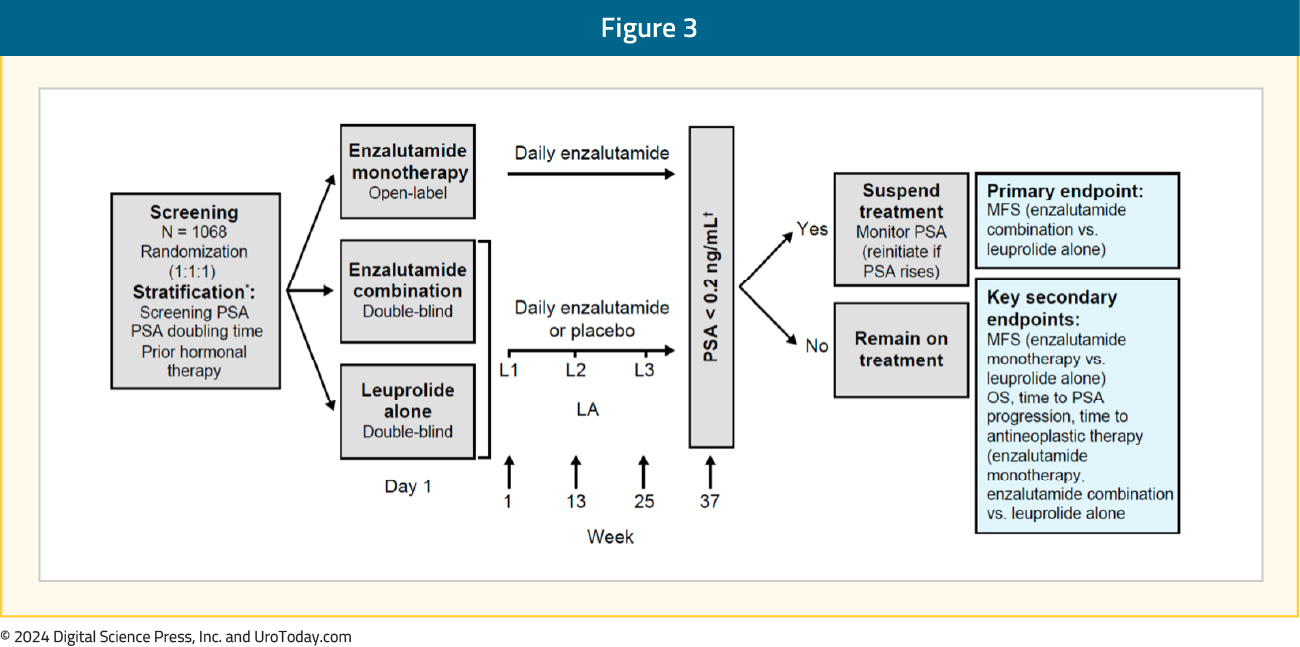
Study Cohort
EMBARK included 1,068 patients, with a median serum PSA level at study entry was 5–5.5 ng/ml. The median PSADT was 4.6–5 months, with approximately 20% of patients having a PSADT ≤3 months. Half of the cohort had undergone both radical prostatectomy and radiation therapy, and 30% of patients had received prior hormonal therapy.
Survival Outcomes
At a median follow-up of 60.7 months, patients in the combination arm of enzalutamide + leuprolide had significantly superior 5-year metastasis-free survival rates (87.3% versus 71.4%; HR 0.42, 95% CI 0.30–0.61, p < 0.001). Subgroup analyses demonstrated consistent benefits for this combination, irrespective of PSADT, baseline age, PSA, geographic region, receipt of prior hormonal therapy, or prior radical prostatectomy:
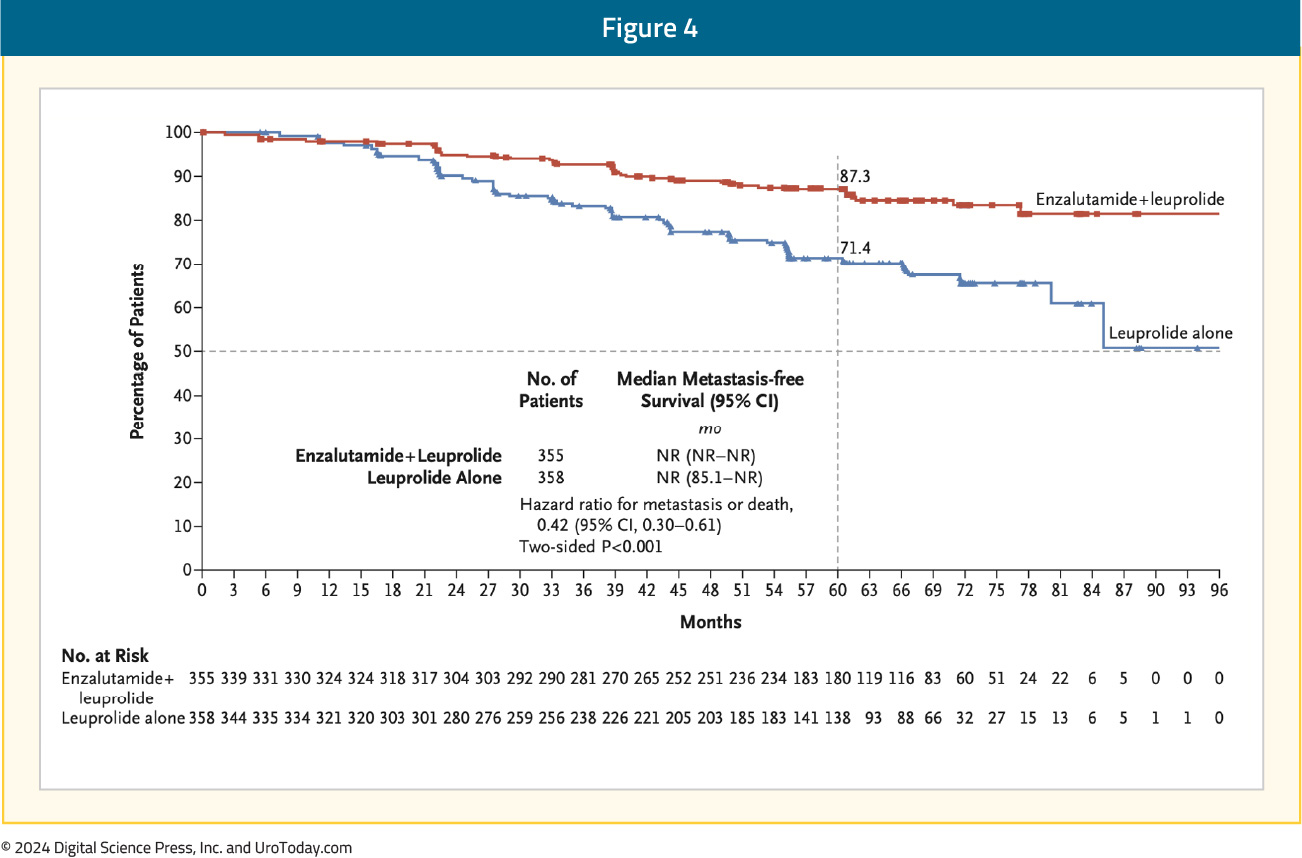
For the comparison of enzalutamide monotherapy to leuprolide monotherapy, patients in the enzalutamide monotherapy arm had superior 5-year metastasis-free survival (80% versus 71.4%; HR 0.63, 95% CI 0.46–0.87, p = 0.005):
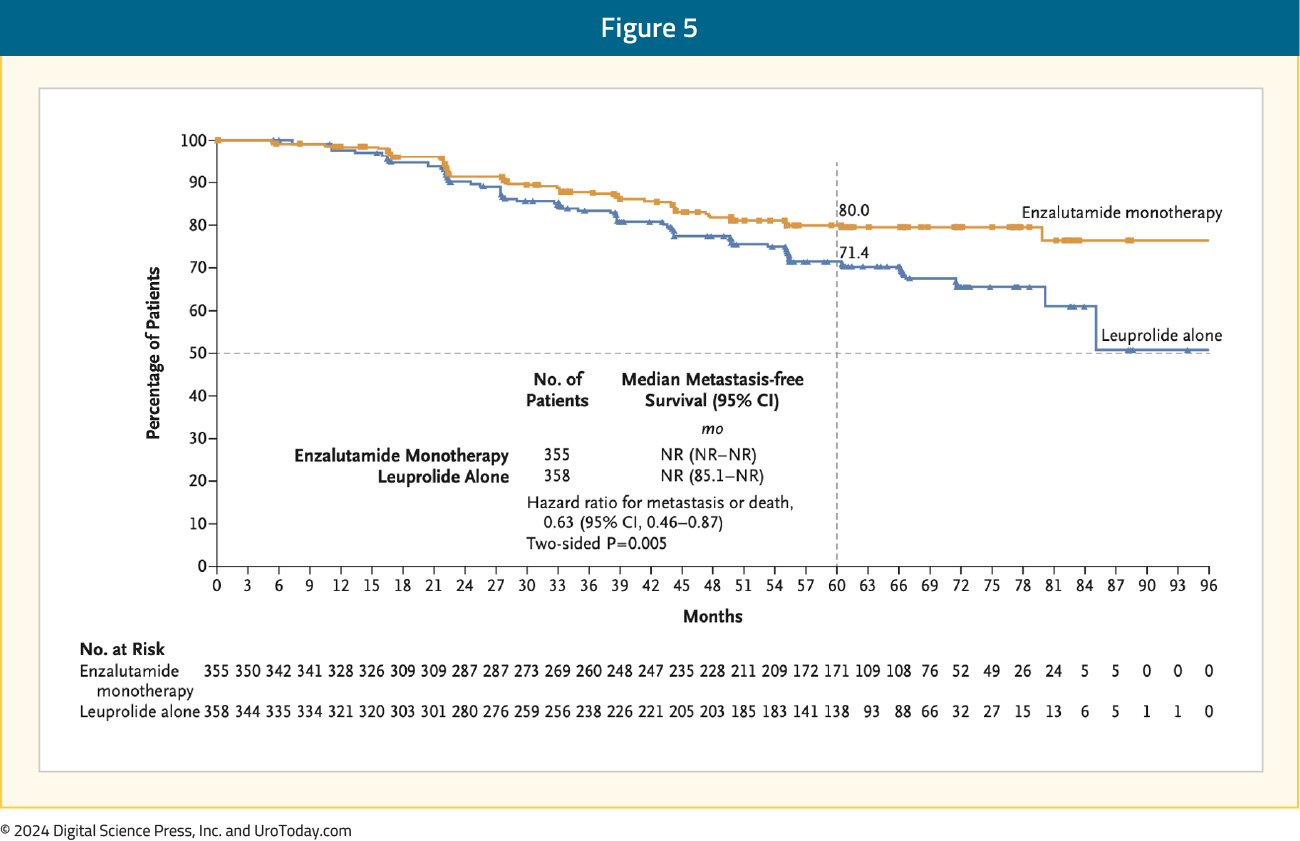
With regards to overall survival, the 5-year survival rates were 92.2%, 87.2%, and 89.5% in the enzalutamide + leuprolide, leuprolide alone, and enzalutamide monotherapy arms, respectively. The hazard ratio for death in the comparison of enzalutamide plus leuprolide versus leuprolide alone was 0.59 (95% CI: 0.38–0.91; p = 0.02):
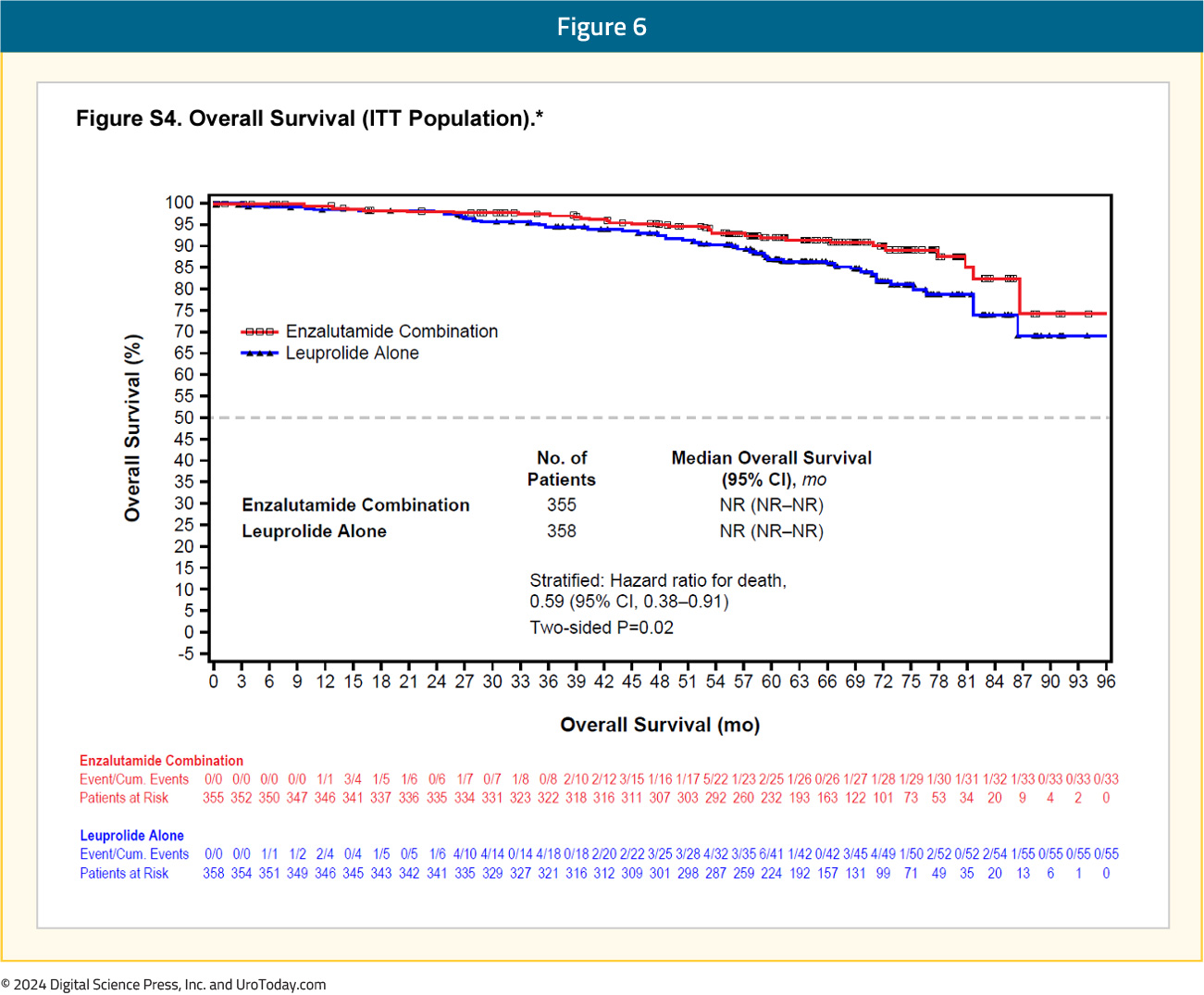
and the hazard ratio for death in the comparison of enzalutamide monotherapy with leuprolide alone was 0.78 (95% CI 0.52–1.17; p = 0.23).
The combination of enzalutamide + leuprolide, compared to leuprolide alone, was associated with significant improvements in the following secondary endpoints:
- PSA progression (HR 0.07, 95% CI 0.03–0.14)
- First use of new antineoplastic therapy (HR 0.36, 95% CI 0.26–0.49)
- Development of castration resistance (HR 0.09, 95% CI 0.05–0.16)
- Symptomatic progression (HR 0.55, 95% CI 0.43–0.70)
- First symptomatic skeletal event (HR 0.26, 95% CI 0.13–0.55)
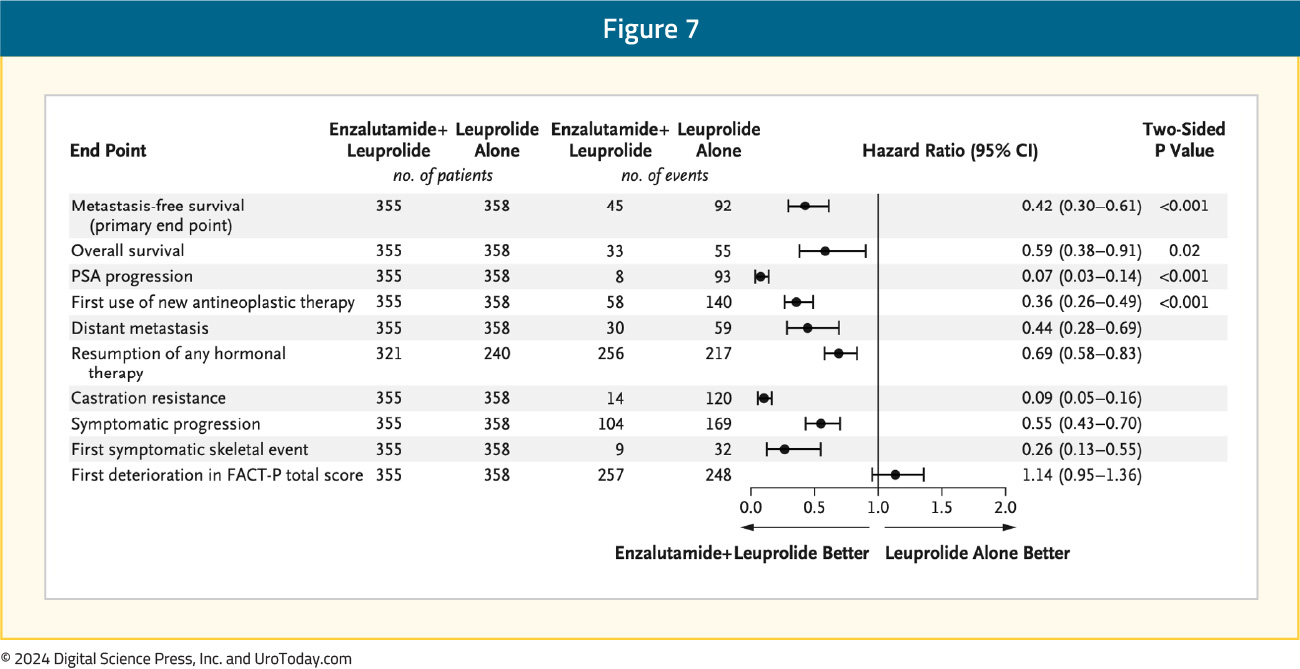
A similar trend was observed for the comparison of enzalutamide monotherapy to leuprolide-only therapy:
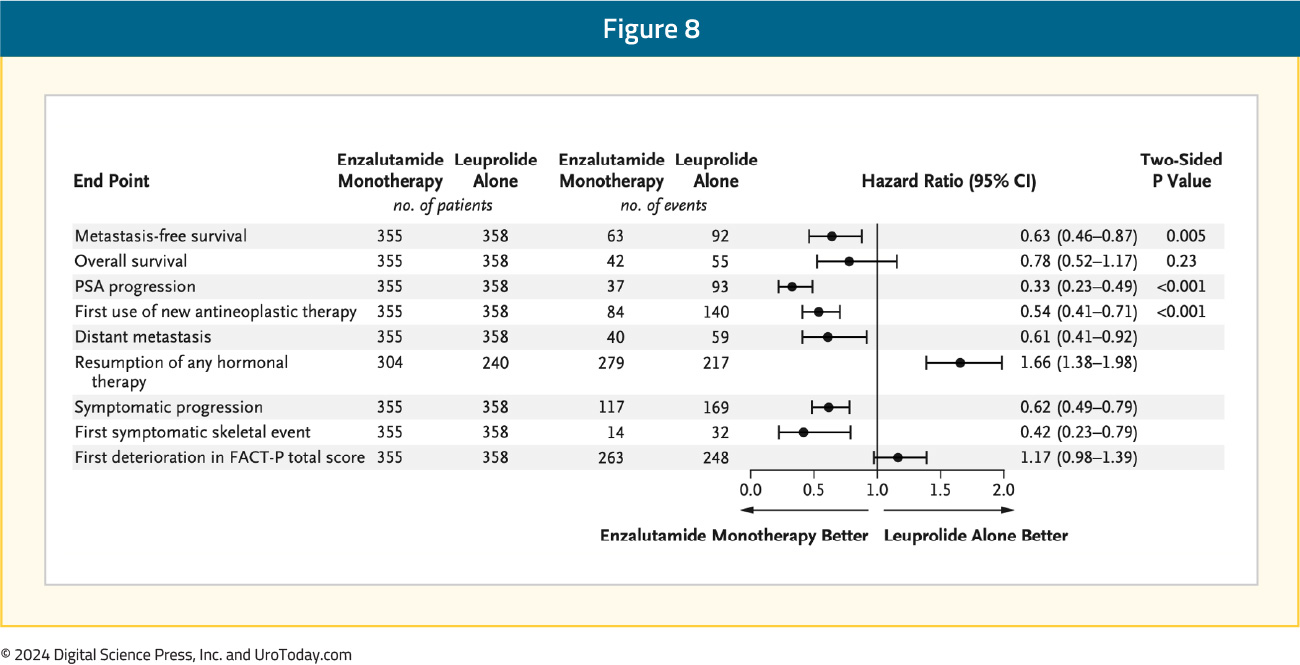
Treatment Suspension Outcomes
With regards to treatment de-intensification (i.e., suspension) at 37 weeks, 91% of patients in the combination enzalutamide + leuprolide group suspended treatment, for a median of 20.2 months. Conversely, 68% of patients in the leuprolide alone group were eligible for treatment suspension, for a median of 17 months. While 86% of patients in the enzalutamide monotherapy arm suspended treatment, the median duration of suspension was only 11 months:
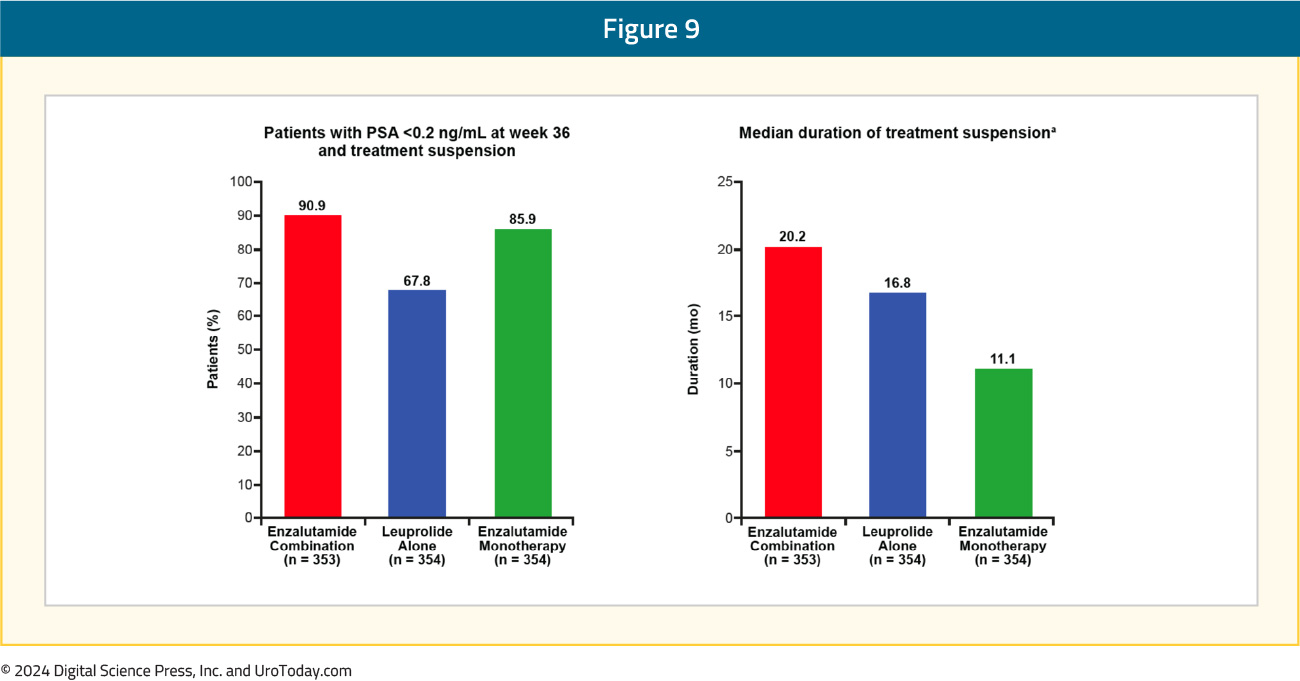
This shorter duration of treatment suspension with enzalutamide monotherapy was likely secondary to the lack of testosterone suppression. In the enzalutamide monotherapy arm, as compared with baseline, the mean testosterone levels were supraphysiologic until treatment suspension at week 37. When treatment was resumed, testosterone levels remained high. In contrast, during treatment suspension in the enzalutamide + leuprolide combination and the leuprolide-alone groups, testosterone recovered slightly, but not to baseline levels, and thus this prolonged testosterone suppression in these two arms, which likely contributed to the longer median durations of therapy:
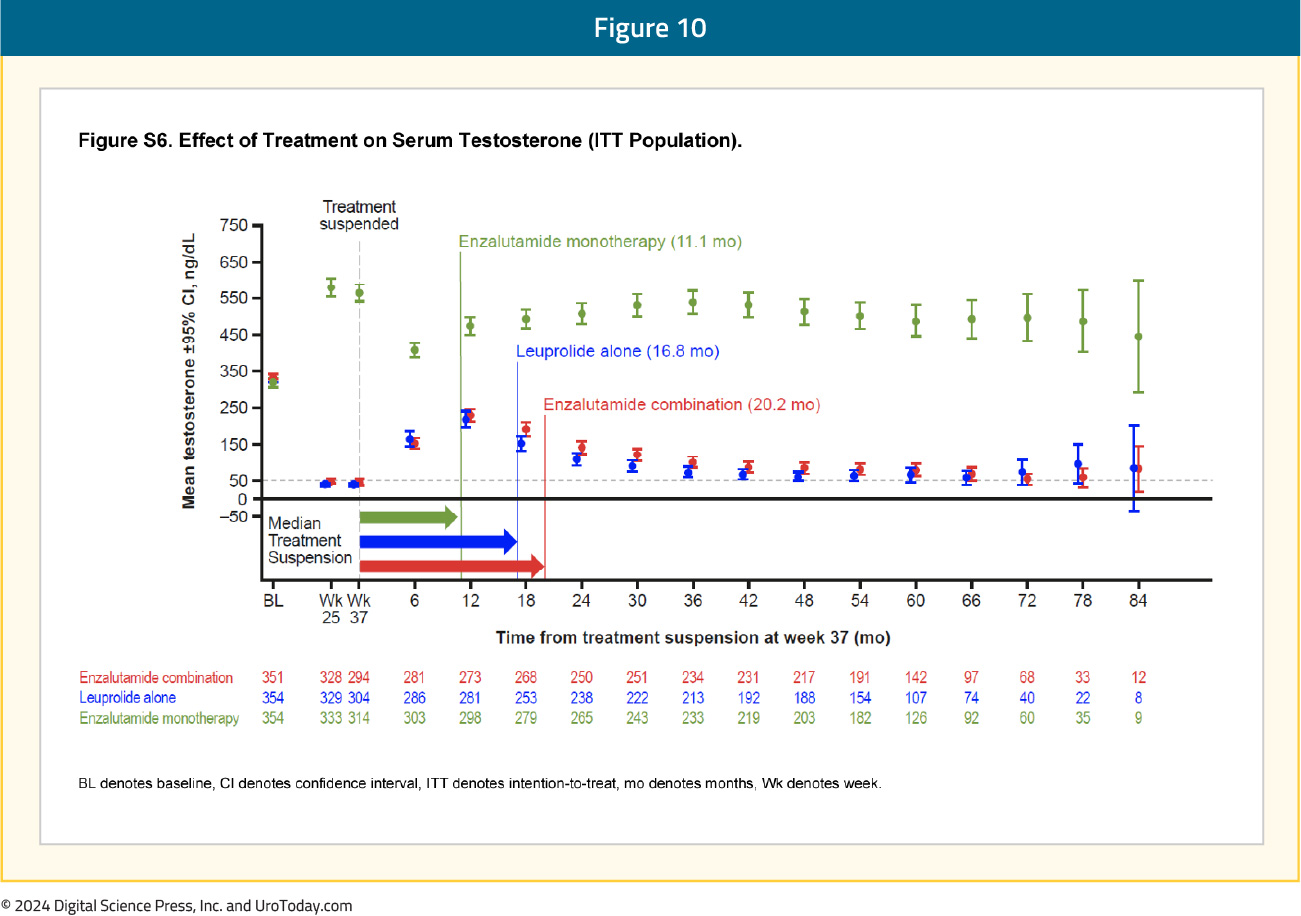
An ad hoc analysis of the EMBARK trial evaluating the outcomes of patients who suspended treatment at week 37 was presented at AUA 2024. Among patients who suspended treatment based on an undetectable PSA level at week 36, treatment was reinitiated in 75%, 84%, and 89% of patients in the enzalutamide + leuprolide combination, leuprolide alone, and enzalutamide monotherapy arms, respectively. Following this treatment re-initiation, 96% of patients in the enzalutamide combination arm achieved an undetectable PSA. Conversely, 73% and 90% of patients in the leuprolide alone and enzalutamide monotherapy arms who reinitiated therapy were able to re-achieve an undetectable PSA.
Among patients who re-achieved an undetectable PSA reading, metastasis-free survival outcomes were generally favorable across all three treatment arms. Conversely, outcomes were significantly worse in those who did not achieve undetectable PSA levels, similar across all three groups, although the sample sizes for this latter subgroup were noticeably smaller (e.g., n=10 in the enzalutamide combination group).
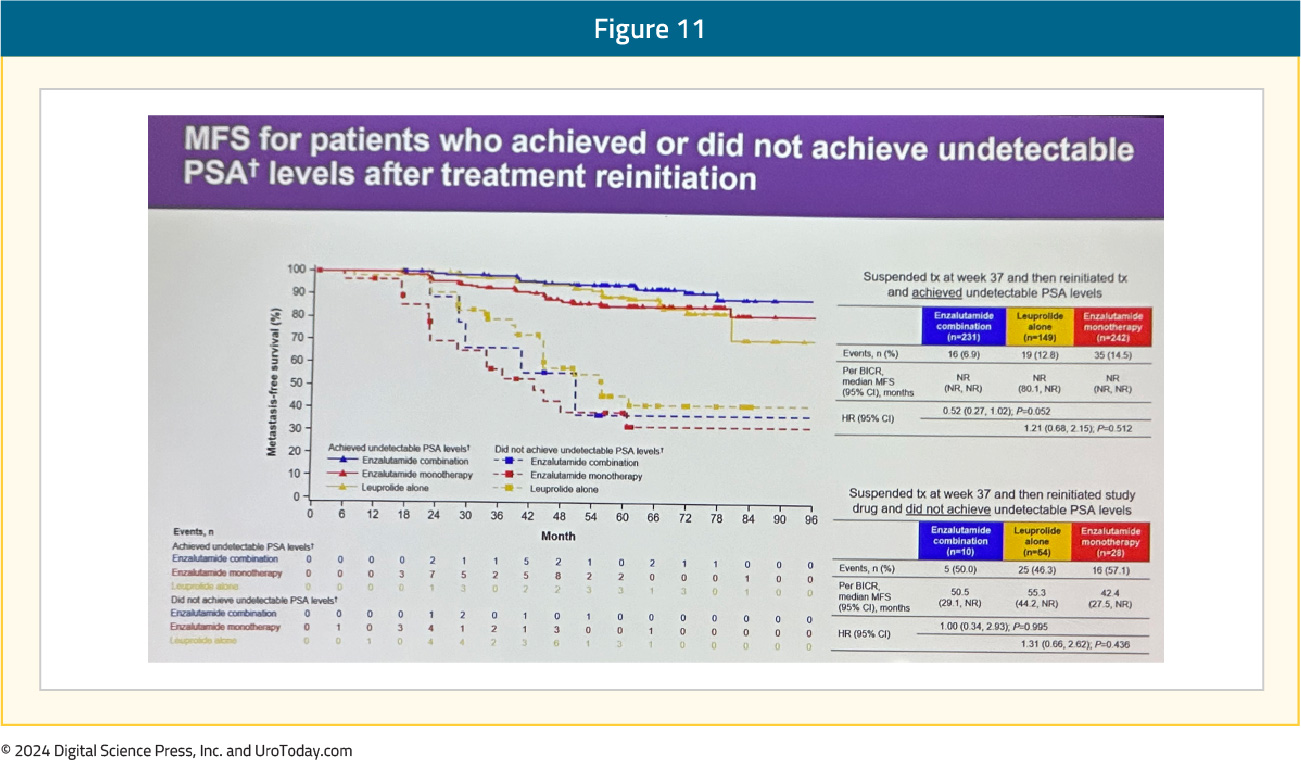
Overall, these results are reassuring that treatment suspension at 37 weeks is safe in patients who achieve undetectable PSA levels at 36 weeks. The majority of patients (75–89%) will eventually require treatment re-initiation; however, almost all patients in the enzalutamide combination arm and 90% of patients in the enzalutamide monotherapy arm are able to re-achieve undetectable PSA levels with favorable survival outcomes.
Post-Hoc Analysis by Age
Given that patients diagnosed with prostate cancer aged >70 years are at greater risk of prostate cancer-related death versus patients diagnosed aged ≤70 years, it is important to understand the efficacy of these treatment intensification regimens. At ESMO 2024, Dr. Neal Shore presented a post-hoc analysis of EMBARK stratified by age. Overall, 543 patients (50.8%) were aged <70 years and 525 patients (49.2%) were ≥70 years. Patients aged <70 years had lower baseline PSA, a higher Gleason score group, and more prior radical prostatectomy versus patients aged ≥70 years across treatment groups. Compared with leuprolide alone, enzalutamide + leuprolide improved metastasis-free survival in both age groups:
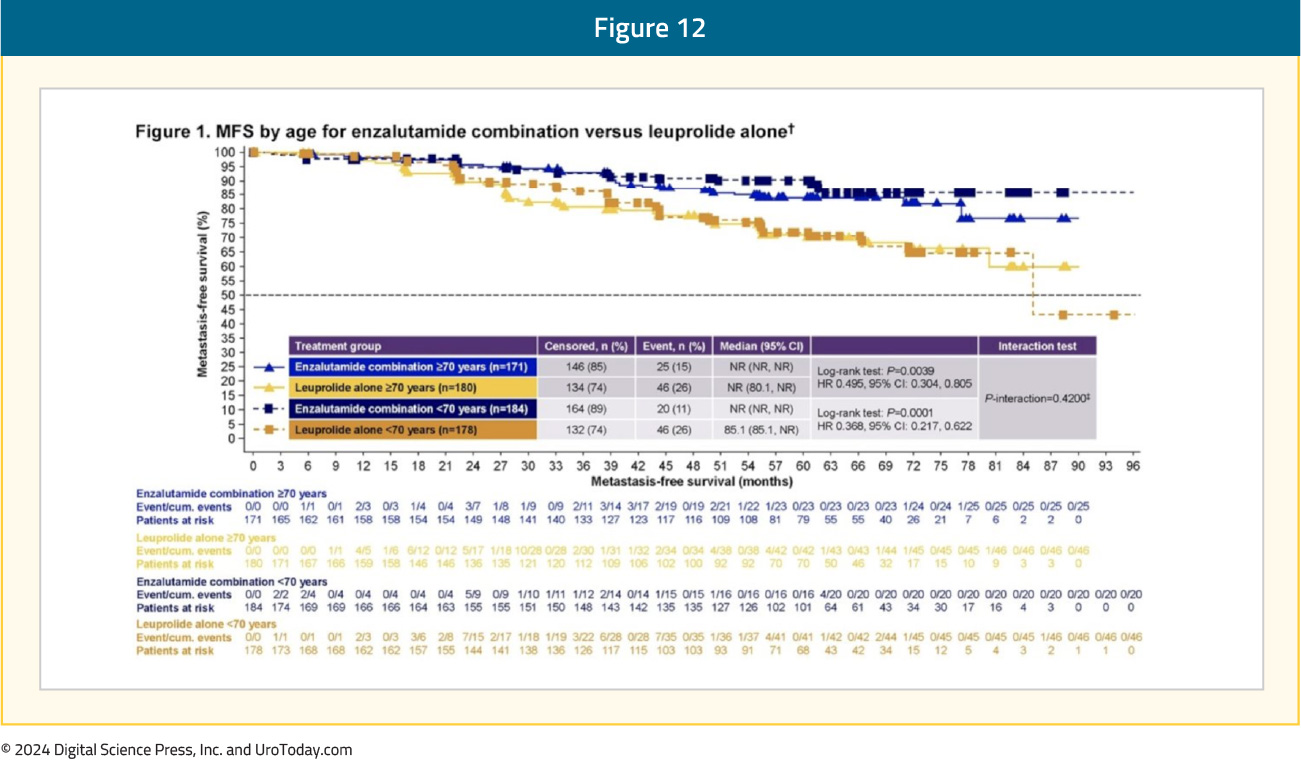
Similar trends were seen with enzalutamide monotherapy. Overall, median treatment suspension duration was similar for patients aged <70 and ≥70 years for enzalutamide + leuprolide and enzalutamide monotherapy, but shorter for patients <70 vs ≥70 years for leuprolide alone. Serious adverse events were more common in patients aged ≥70 years vs <70 years for enzalutamide + leuprolide (45.0% vs 25.3%), leuprolide alone (36.2% vs 27.1%), and enzalutamide monotherapy (43.9% vs 30.4%). For clustered treatment emergent adverse events of special interest of any grade, musculoskeletal events, fatigue, and hypertension were common across all age and treatment groups. As such, even though (as expected) adverse events are likely higher among men ≥70 years, based on the efficacy and tolerability, elderly men with high-risk biochemical recurrent prostate cancer, in a setting of shared decision-making, may be considered for treatment intensification.
Safety
No new safety signals were observed with the combination of enzalutamide and leuprolide. Grade ≥3 adverse events were observed in 43-50% of patients across the three arms. The most common adverse events (occurring in ≥10% of patients) in the enzalutamide combination group and the leuprolide-alone group were hot flashes (57–69%) and fatigue (33–43%). The most common adverse events in the monotherapy group were gynecomastia (45% versus 8–9% in the two other arms), hot flashes (22%), and fatigue (47%). Notable adverse events in the enzalutamide monotherapy group were nipple pain (15% versus 1–3% in the other two arms) and breast tenderness (14% versus 1% in the other two arms). Fractures were more common in the enzalutamide combination group (18.4%), compared to the leuprolide-alone group (14%) and the enzalutamide monotherapy group (11%):
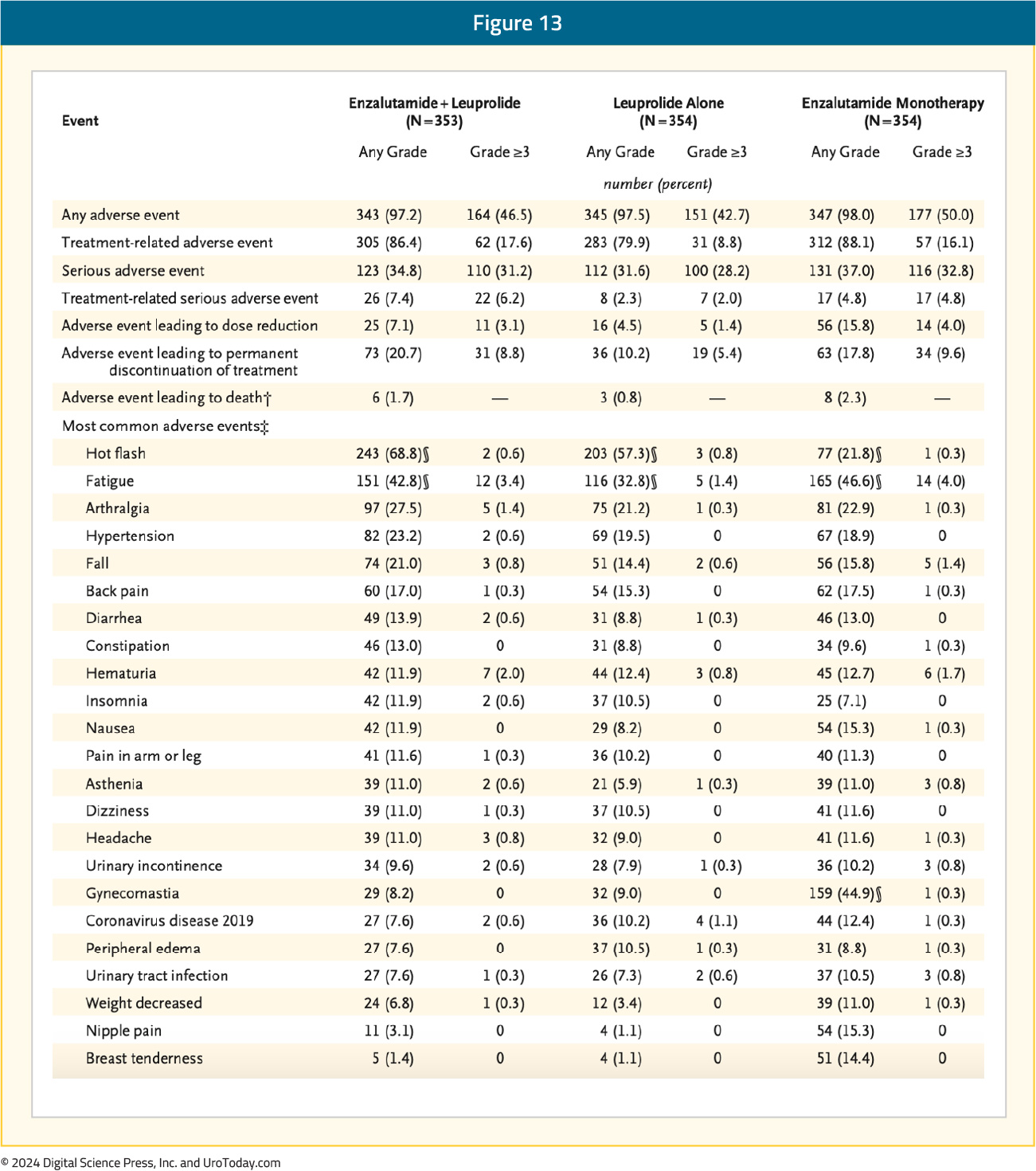
Treatment was discontinued due to adverse events in 21% of patients in the enzalutamide combination group, 10% of patients in the leuprolide-alone group, and 18% of patients in the enzalutamide monotherapy arm. The most common adverse event leading to discontinuation in all three arms was fatigue.
Conclusions
Based on the results of the EMBARK trial, the 2024 NCCN guidelines now endorse enzalutamide, with or without concurrent leuprolide, as a recommended treatment option for select high-risk patients with progressive M0 HSPC following maximal pelvic therapy. In November 2023, the United States Food and Drug Administration (FDA) approved enzalutamide, with or without leuprolide therapy, for M0 HSPC patients with biochemical recurrence at high risk for metastasis.8 While both enzalutamide monotherapy and enzalutamide combination therapy with leuprolide demonstrate metastasis-free survival benefits compared to leuprolide-only therapy, it is important to consider the impact of these drugs on health-related quality of life outcomes, including sexual side effects.Published October 2024


